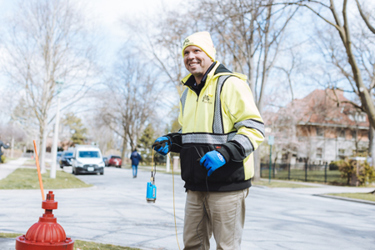Illi-noise: Small Sounds Unearth Leaks, Big Savings For Chicago Suburb
By Terrilynn Short and Beth Powell

Each year, a diverse mix of global participants from many professional backgrounds come together in Stockholm during World Water Week to attend sessions, engage in discussions, and absorb a wealth of information on varied water challenges and solutions. Organized by the Stockholm International Water Institute, the conference reminds us of the importance of tackling the global issue of water conservation.
The Global Water Crisis
Globally, more than 8.5 trillion gallons of water is lost each year due to leakage. Outdated infrastructure is one of the main reasons for this. Nearly a third of the world's lost water occurs in the U.S., where undetected leaks in pipes lead to the daily loss of 7 billion gallons of treated water. This costs the nation's water industry and its consumers billions of dollars annually. However, it also has a detrimental impact on people and the environment. It can mean shortages for drinking, farming, and industry, as well as leading to higher costs for everyone. While less water in rivers and lakes can harm animals and plants, making it harder for them to find what they need to survive.
Case Study: Combating Water Loss Through Leakage
As a thriving Chicago suburb, Oak Park is famous for, amongst other things, its historic architecture including Frank Lloyd Wright’s Unity Temple (a UNESCO World Heritage site). It also has one of the oldest water networks in the U.S., with some components dating back to the late 19th century.
Michael Bills, the Water & Sewer Superintendent for the Village of Oak Park, is responsible for maintaining its aging 105-mile network of pipes to ensure that 1.7 billion gallons of safe, drinkable water reaches 54,000 residents annually.
Oak Park has a Lake Michigan water allocation and purchases treated water from the City of Chicago. However, the village was losing around 20% of its water through leaks each year. This amounts to roughly 350 million gallons of water or the equivalent to 530 Olympic-sized swimming pools, enough to provide drinking water for a neighborhood ten times the population of Oak Park.
As a result, Oak Park set itself a target of reducing water loss to 10% to meet the Illinois Department of Natural Resources regulation for Lake Michigan water users. However, the aging water network was put under further pressure due to the regional temperature extremes, which put additional stress on the pipes and made them break more easily. The local porous soil also prevented leaks from surfacing, so they were difficult to spot. Something needed to be done.
As one strategy to combat water loss through leakage, Oak Park started a pilot project with HWM, a Halma company that makes environmental monitoring technologies that helps listen for leaks in aging networks. Its Fluid Conservation Systems (FCS) technology uses sensors, called loggers, that were placed along a third of the Oak Park water network, attached to its pipes with magnets. These loggers pick up the smallest sounds made by water leaks. As soon as the tell-tale noise of a water leak — similar to the sound of a flute — is detected, the sensor converts it into a digital signal and alerts the system.
From there, Michael and his team can access a digital map of all possible water leaks in the network, helping them to prioritize what needs to be fixed rather than spending time sending engineers to every alert ensuring that the limited resources are deployed most effectively.
The successful pilot program helped Oak Park identify 19 leaks that had not surfaced, making them otherwise undetectable. The Village of Oak Park has now implemented acoustic loggers throughout their entire water network and has found a further 10 leaks within the first month.
“Conventional leak detection methods can take up to a year, or even longer, to locate pipe failures after they occur. The use of the permanently mounted FCS logger checks the pipe network at night when the system is quiet, allowing us to respond to a leak as soon as it is detectable. This helps to save valuable resources for the Village of Oak Park.”
- Michael Bills, Water & Sewer Superintendent, Village of Oak Park
[To learn more about the Oak Park story, watch this video.]
Oak Park is just one example of how smarter water technology can tackle the issue of aging water infrastructure. As the U.S. invests billions in the modernization of its water and wastewater systems, it will be critical for municipalities to look at technology that can predict leaks, patrol pipes, and provide real-time insight into managing water infrastructure.
HWM and Halma’s other water companies are committed to helping communities and businesses around the world to improve water sustainability, quality, and availability. By using smart water technology, we can start to protect this life-critical resource for future generations.
